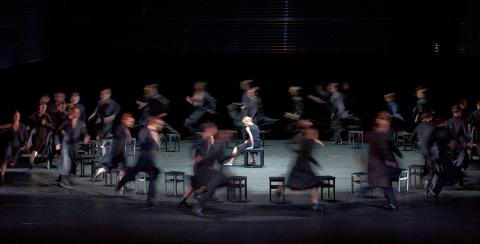The National Kaohsiung Center for the Arts (Weiwuying) opens its portion of the 11th Taiwan International Festival of Arts (TIFA) this weekend with two performances by the Ballett am Rhein Dusseldorf Duisburg, with artistic director Martin Schlapfer’s 7.
The troupe is making its Taiwan debut with the Kaohsiung shows, might be a first-time visitor to the nation, but it is very familiar with Weiwuying’s artistic director, Chien Wen-pin (簡文彬), who moved to Dusseldorf, Germany, in 1996 to become a conductor at the Deutsche Oper am Rhein, which is also home to the ballet company.
Tanz, Europe’s premier dance magazine, named Schlapfer its “Choreographer of the Year” in 2010, just a year after he took over the revived Ballett am Rhein, and has named the troupe “Company of the Year” four times, from 2013 to 2017.

Photo courtesy of the National Kaohsiung Center for the Arts
The company’s appearances in Taiwan will be special because it will be accompanied by the Taipei Symphony Orchestra (台北市立交響樂團), which will be conducted by Chien.
Ballet performances in Taiwan that feature live music are a rarity: Taiwanese choreographer Allen Yu (余能盛) made a point to have an orchestra for his productions for the Chamber Ballet Taipei — later the Formosa Ballet (福爾摩沙芭蕾舞團). Visiting troupes such as the Kirov Ballet sometimes bring their own, but otherwise dancers usually perform to recordings.
Chien began working with Schlapfer and the ballet company in 2012 and the two men collaborated from the beginning on 7, which premiered in October 2013 and is set to Gustav Mahler’s Symphony No. 7.
In an interview posted on Weiwuying’s Web site, Chien said he is eager for Taiwanese audiences to see how Schlapfer connects Mahler’s piece with modern social issues.
Chien ranks the Swiss-born Schlapfer as one the of two choreographers he knows who have the best ears for music; the other is Cloud Gate Dance Theatre (雲門舞集) artistic director Lin Hwai-min (林懷民).
“When they hear music, they can instantly grasp the context and development of the melody, and even predict the next note,” he said.
Mahler’s works are popular among conductors because they “have a clear sense of what the conductor should do,” he said.
Symphony No. 7 is not as well-known as Mahler’s other works, and has been sometimes called his “problem child,” with its awkward first movement, but Schlapfer used that difficult opening to create a whirlwind of activity, filled with dancers in dark costumes and a variety of footwear (or none), before segueing into calmer waters and combinations of pairs and groups, a romantic pas de deux and pointe work.
He has been quoted as saying that “the more I listen to the ‘7,’ the crazier it gets. Mahler’s music releases things in my own choreography which I did not believe I had in me.”
The ballet runs 80 minutes, with no intermission. Following his weekend’s shows in Kaohsiung, the company and orchestra will give two performances at the Grand Theater in the National Taichung Theater to open its TIFA program.

This month the government ordered a one-year block of Xiaohongshu (小紅書) or Rednote, a Chinese social media platform with more than 3 million users in Taiwan. The government pointed to widespread fraud activity on the platform, along with cybersecurity failures. Officials said that they had reached out to the company and asked it to change. However, they received no response. The pro-China parties, the Chinese Nationalist Party (KMT) and Taiwan People’s Party (TPP), immediately swung into action, denouncing the ban as an attack on free speech. This “free speech” claim was then echoed by the People’s Republic of China (PRC),

Exceptions to the rule are sometimes revealing. For a brief few years, there was an emerging ideological split between the Democratic Progressive Party (DPP) and Chinese Nationalist Party (KMT) that appeared to be pushing the DPP in a direction that would be considered more liberal, and the KMT more conservative. In the previous column, “The KMT-DPP’s bureaucrat-led developmental state” (Dec. 11, page 12), we examined how Taiwan’s democratic system developed, and how both the two main parties largely accepted a similar consensus on how Taiwan should be run domestically and did not split along the left-right lines more familiar in

As I finally slid into the warm embrace of the hot, clifftop pool, it was a serene moment of reflection. The sound of the river reflected off the cave walls, the white of our camping lights reflected off the dark, shimmering surface of the water, and I reflected on how fortunate I was to be here. After all, the beautiful walk through narrow canyons that had brought us here had been inaccessible for five years — and will be again soon. The day had started at the Huisun Forest Area (惠蓀林場), at the end of Nantou County Route 80, north and east

Specialty sandwiches loaded with the contents of an entire charcuterie board, overflowing with sauces, creams and all manner of creative add-ons, is perhaps one of the biggest global food trends of this year. From London to New York, lines form down the block for mortadella, burrata, pistachio and more stuffed between slices of fresh sourdough, rye or focaccia. To try the trend in Taipei, Munchies Mafia is for sure the spot — could this be the best sandwich in town? Carlos from Spain and Sergio from Mexico opened this spot just seven months ago. The two met working in the